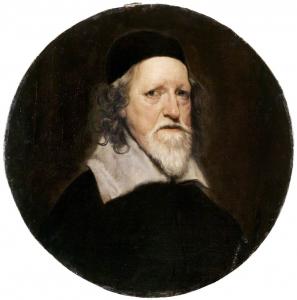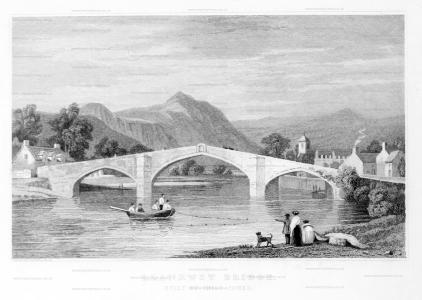Biography of Inigo Jones 1573-1652
On 15 Jul 1573 Inigo Jones was born.
On 05 Jun 1610 the Tethy's Festival Masque was performed at Whitehall Palace [Map] to celebrate the the investiture of Prince Frederick (age 16) as Prince of Wales. The script was written by Samuel Daniel at the request of the Queen (age 35), who appeared in person as Tethys a goddess of the sea. Inigo Jones (age 36) designed the staging and scenery.

Prince Charles (age 9) took the part of Zephyrus,.
Princess Elizabeth Stewart Queen Bohemia (age 13) appeared as the companion or daughter of Tethys, the "Nymph of Thames",.
Arabella Stewart (age 35) took the part of the "Nymph of Trent",.
Alethea Talbot Countess Arundel, Surrey and Norfolk (age 25) as "Nymph of Arun".
Elizabeth Vere Countess Derby (age 34) as "Nymph of Derwent",.
Frances Howard Countess Essex and Somerset (age 20) as "Nymph of Lee",.
Anne Clifford Countess Dorset and Pembroke (age 20) as "Nymph of Air",.
Susan Vere Countess Montgomery (age 23) as "Nymph of Severn",.
Elizabeth Radclyffe Viscountess Haddington as "Nymph of Rother",.
Elizabeth Talbot Countess Kent (age 28) as "Nymph of Medway",.
Four sisters, daughters of Edward Somerset 4th Earl of Worcester (age 60) and Elizabeth Hastings Countess of Worcester (age 64), danced as the rivers of Monmouthshire:

Catherine Somerset Baroness Windsor (age 35) the "Nymph of Usk".
Katherine Somerset Baroness Petre (age 35) the "Nymph of Olwy".
Elizabeth Somerset (age 20) the "Nymph of Dulesse" (Dulas), and.
Mary Wintour the "Nymph of Wye".
The The Golden Age Restored Masque was a Jacobean era masque, written by Ben Johnson (age 44) and designed by Inigo Jones (age 42); it was performed on 01 Jan 1616 and 06 Jan 1616, almost certainly at Whitehall Palace.
 Around 1644. William Dobson (age 32). Portrait of Inigo Jones (age 70).
Around 1644. William Dobson (age 32). Portrait of Inigo Jones (age 70).
On 21 Jun 1652 Inigo Jones (age 78) died.
 Around 1757 William Hogarth (age 59). Portrait of Inigo Jones. The portrait was commissioned by Edward Littleton 4th Baronet (age 30) when he was refurbishing his house Teddesley Hall, Penkridge.
Around 1757 William Hogarth (age 59). Portrait of Inigo Jones. The portrait was commissioned by Edward Littleton 4th Baronet (age 30) when he was refurbishing his house Teddesley Hall, Penkridge.
Wales Illustrated North Wales. Llanrwst Bridge [Map] And Church.
Llanrwst is a small town, pleasantly situated on the river Conway, in Denbighshire, and though but a small place, it monopolises the chief trade of the surrounding district. The bridge [Llanrwst Bridge, Clywd [Map]] is considered the principal object worthy of notice, having been built after a design by the celebrated Inigo Jones, who is said to have been a native of the place, and who also furnished the design for the chapel, adjoining the church. Though not magnificent, the bridge is certainly a handsome structure, and displays somewhat of the genius of its farfamed architect. It was built by an order from the privy council, in the 9th year of Charles the first ; the expense, estimated at one thousand pounds, being conjointly defrayed by the counties it connects — Caernarvon and Denbigh. It consists of three arches, the central one the largest, measuring nearly sixty feet in the span; — it is asserted that this bridge is formed upon such nice principles, that when a person pushes against the large stone placed over the middle arch, the whole fabric may be felt to vibrate. The scenery, both above and below, is enchanting; gratifying the sight with the finest objects, grouped in endless variety. The hills and woods, which line both margins of the river, are enlivened by the busy display of small vessels on its surface, going to and from Triefrew, a village about two miles down, and the highest point to which the tide flows; or with still more diminutive coracles, fishing for salmon and smelts. Less extended than the vale of Clwyd, and wider than that of Llangollen, the vale of Llanrwst has often been admired, as exhibiting the most variegated assemblage of beauty; it has been the subject of eulogium of that competent judge, both of the sublime and beautiful, Mr. Burke, who pronounced it, "the most charming spot he had seen in Wales." This place was famous for the manufacture of Welsh harps; but in 1810, the harp makers had become extinct, no one carrying on that business, and the instrument becoming scarce, rose in price; those, by the best makers, fetching twenty-five guineas.
